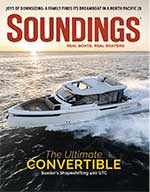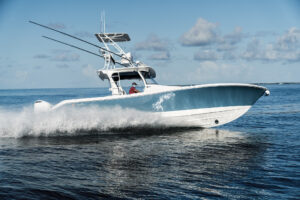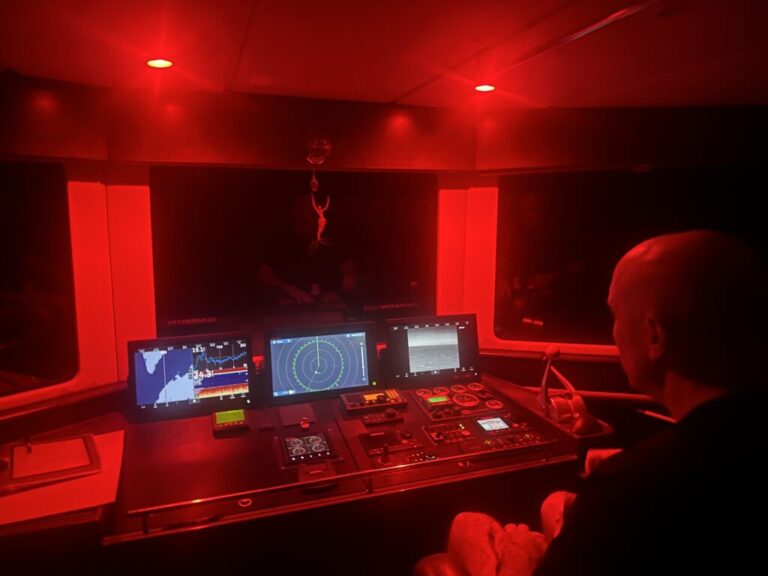
When Brunswick Corp., the parent company of Sea Ray, Boston Whaler and other brands, decided to hold a virtual boat show on July 21 and 22, Ritch Ragle and his team had to do something different: be available online to consumers in a newly organized way, for 12 full hours each day.
Ragle is the director of North American sales and customer service for Sea Ray, which means he’s used to talking with consumers at places like in-person boat shows. But the level of interaction that happened during the virtual boat show, he says, was beyond anything he could have possibly imagined. People who may have lurked online saw so many other participants asking questions that they also jumped in. People who may never have attended an in-person show logged on and felt comfortable immediately, checking out the models and accessories at their own pace from the comfort of their homes or current boats.
“It actually gave everybody access to the factory,” Ragle says. “We could interact with a customer in Topeka, Kansas, who maybe never would have been able to talk to somebody at Sea Ray. We had customer service available to answer questions. And we have all of that on our website today. When you talk about a virtual boat show, we learned people were much more engaged with us than usual.”
The phenomenon that Ragle experienced is part of a broader online boat-shopping frenzy that the Covid-19 pandemic has triggered nationwide. Thousands of boat buyers, even if they would prefer to shop in person, have been forced to make their peace with the virtual experience. No matter whether it’s shoppers for center consoles, trawlers or superyachts, the pandemic has forced a change in the way people research and buy boats.
Industrywide, dealers and brokers say much of the shopping process that happened in person is now being done at least in part—and sometimes entirely—online. Boaters who used to do tours at dealerships or boat shows are now “touring” their future vessels by way of FaceTime, Zoom or Skype. Online research that used to supplement in-person, hands-on shopping is now the primary tool that consumers are using to decide which boat they want. For smaller boats and tenders, some buyers are clicking to purchase without ever laying eyes on the physical vessel.
“We have figured out how to sell boats with our showrooms on lockdown. We have figured out how to sell boats without boat shows and on-site sales—and in the Boston market, our sales are up 200 percent. There’s a clear embrace of the new technology,” says Larry Russo Sr., who is senior vice president at MarineMax, which has more than 60 dealerships nationwide. “If we didn’t have the pandemic, this would have taken 10 to 15 years for the industry to morph into advanced digital strategy. The pandemic forced it to happen in three months.”
Howard and Ginger Robin learned that lesson firsthand. After decades of owning boats, this couple knew what they wanted: a Nordhavn 60. But as they started to shop from their home near San Francisco, only three N60s were for sale, and of those three, only an N60 in Florida had a U.S. electrical system. That was the boat they wanted to see, they told their broker, Jeff Merrill of Jeff Merrill Yacht Sales in California.
“This was in early March, right before Covid-19 became highly problematic,” Howard Robin recalls. “Ginger and I flew to South Florida and went to look at the boat with Jeff. We spent five hours going through the boat. It needed some work, but it was great.”
The Robins flew home to think things over, negotiated a price for the 2013 build, and signed a deal to buy it. But by the time they were ready to do a survey, the pandemic had begun to shut down airports. “I would never intentionally buy a boat without being there for the sea trial and the survey,” Robin says, but “there was no reasonable way for me to fly to Fort Lauderdale.”
Robin ended up embracing digital shopping tools far more than he ever imagined possible. He wasn’t able to do a sea trial, but his consultant, Virginia-based Steve d’Antonio, and another expert he trusted, Capt. Bernard Francis of Florida, could get to the boat safely, traveling by car. They kept Robin informed by phone as they surveyed and ran the vessel.

“The N60 costs seven figures. That’s an expensive boat to buy after looking at it once,” Robin says. “But Covid changed everything. It was either trust Steve and Bernie, or don’t buy the boat.”
As with buyers of new vessels, Robin says, a lot of his decision boiled down to knowing and trusting the builder’s reputation. “It’s not an unknown brand,” he says. “With Nordhavn, I had no worries about the fundamental qualities of the boat.”
Today, the newly rechristened Ginard is in a shipyard in Canada being refitted. Robin is checking in on the progress twice a week via Facetime. The yard’s workers hold up their smartphones to show him different areas of the boat, and he makes decisions that are necessary. “I can’t even imagine it, even having done it,” he says. “You’ve got to do what you’ve got to do.”
The shift to virtual shopping is happening at all price points, for new and brokerage boats alike. According to the National Marine Manufacturers Association, the Discover Boating website has seen triple-digit traffic growth during the pandemic, and a whopping 70 percent of dealers for new and brokerage boats were reporting retail sales growth as of May. New boat sales overall shot up 59 percent between April and May, according to the NMMA, and were up 19 percent year-over-year compared to May 2019.
And a lot of those boats—even larger 30- and 40-footers—appear to be going to first-time boat buyers. The data is still being analyzed, but Ellen Hopkins Bradley, senior vice president and chief brand officer for the NMMA, says the fact that so many new buyers entered the market so quickly (many of them looking for an outdoor, socially distanced activity) pushed dealers and manufacturers to improve their virtual tools, and fast.
“They’re probably younger and digitally savvy—some of the data do show that,” she says. “They’re more digital natives, so that’s how they expect to shop. When they started going online to shop for boats, the retailers and manufacturers had to adapt really quickly. I would venture to say that most dealers were not selling boats online last year. They are now.”
Virtual show organizers and attendees alike are still figuring out the best ways to navigate the online-shopping environment, experts say. Because so many people were rushing to buy boats this summer, inventory was all but wiped out. Because of low inventory, dealers of boats up to 35 feet said the best buying strategy was to have a general idea of what might be ideal—say, a size range and a feature or two—and then purchase whatever boat was in stock that came closest as a match.
For buyers willing to take delivery in 2021 and beyond, as the pandemic’s effects (hopefully) ease up, Bradley says there should be a spate of new online shopping features available soon, as dealers look at what worked and what could be done better via the internet going forward.
“I think that over the next nine months or so, we will start to see some of those shining pieces come out, and we’ll say, ‘Oh my gosh, why didn’t we do that years ago?’” she says.
One thing is for sure: Builders and dealers have realized they need to invest in making the online shopping experience as comfortable for consumers as possible.

Justin Joyner, the powerboat manager for Beneteau America, says he used to be on the road 10 to 14 days a month talking face-to-face with clients about boats including the Swift Trawler series. He stopped traveling in mid-March because of the pandemic, and within about a month started receiving calls from dealers asking him to do virtual walkthroughs with clients. Joyner then built a database of 360-degree boat-tour videos that he could tap into, no matter which model a client wanted to see.
“I literally started sharing my desktop and taking customers through these boats by video and by picture,” he says. “You have to intimately know these boats—what’s behind that cabinet, what’s here, what’s that. You aren’t there in person, so you have to know the location of the 110 breaker is behind that cabinet, and where the inverter switch is.”
Joyner says he was doing, easily, 10 calls a week of an hour to two hours apiece for 40- to 50-foot boats. When a client seemed ready to purchase a boat, Joyner would arrange to meet him or her on board, in person at a safe social distance, for the first time.
“I can say, ‘OK, you live outside of New York City, well, I’m arranging to have a boat ready for you to view on the 23rd where you can drive in your own car for four hours, and I’ll meet you at the boat,’” Joyner says. “It’s that last piece of validation before they order their boat. The very strong majority of people still physically are getting on one of the boats before they pull the trigger and purchase, but it’s the last step, not the first step.”
For smaller boats that are new instead of brokerage, Russo says, that last in-person step has now been eliminated entirely for many MarineMax purchases. “We sold the majority of these boats with no physical contact with the customers,” Russo says of the booming pandemic sales. “People have an enormous amount of faith in the Boston Whaler brand. The Sea Ray brand. The Azimut brand. People are willing to take a leap of faith that these are good boats.”
Ragle says that once dealers and manufacturers got the online processes down, clients flocked to them. During past recessions, he says, he’s seen one end of the market or the other expand; either everyone is downsizing into small boats, or the upper end of the market booms from people with money snapping up deals.
The current recession that the pandemic has wrought, he says, is different. All the market segments are expanding at the same time, and they are expanding in a way that includes a virtual-shopping component. In the past, for instance, a shopper would get to know a dealer and then buy a boat. Today, that interpersonal dance is being done in reverse.
“We’re finding more and more that the relationship with the dealer starts online,” he says. “It’s the service after the sale that cements the relationship. Part of it is the millennials coming into boating with Venmo and Snapchat. They don’t want the typical buying process. They don’t want the back-and-forth with the salesperson and the counteroffers.”
Going forward, Ragle says, Sea Ray is like pretty much every boatbuilder in the country, watching the effects of the pandemic to see whether traditional boat shows can return safely. The past few months have shown another way forward, a way that, in some respects, is a better shopping experience for the consumer and a better sales opportunity for the dealer.
“If boat shows continue to be canceled or restricted, maybe this will provide all of the resources in one place,” he says. “At a virtual show, I can show every boat, every option, every model, every color. You can’t touch it and feel it, but you have better exposure to the product.”
Does that mean virtual shopping is the way of the future for boating, and that the spectacle of in-person boat shows may become a thing of the past? As with so many things related to Covid-19, experts are still trying to figure out the answers.
“If you talk to most consumers, they’ve made up their mind before they go to the show, and they’re just looking for the best price,” Ragle says. “If we can facilitate that without spending millions of dollars in transportation and all the rest of it, and not expose ourselves to health problems, it’s something we need to continue to explore.”
Even still, Bradley says, the NMMA team believes there is a need for an in-person component to boat shows in the years going forward.
“We’ve been getting emails from attendees saying they want the shows to go on,” she says. “They like to see the product in person. They like to be able to compare and see all the different boats. So, there’s room for that in-person experience to come back.”
This article was originally published in the October 2020 issue.










